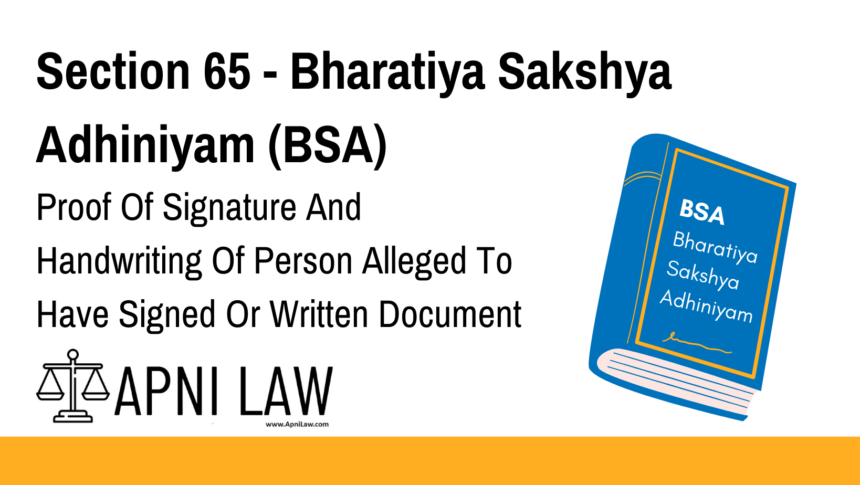Code: Section 65 BSA
If a document is alleged to be signed or to have been written wholly or in part by any person, the signature or the handwriting of so much of the document as is alleged to be in that person’s handwriting must be proved to be in his handwriting.
Section 65 – Bharatiya Sakshya Adhiniyam (BSA)
Explanation of Section 65 BSA
Section 65 of the Bharatiya Sakshya Adhiniyam (BSA) pertains to the authentication of handwritten documents. When a document is presented in court and it is claimed that it has been written or signed by a particular person, the handwriting or signature must be proven to belong to that individual.
This section ensures that no document is accepted at face value unless its authenticity is established through proper legal means.
Key Principles:
-
Applies to both full and partial handwritten documents.
-
Applies to signatures as well as body text in a person’s handwriting.
-
Handwriting or signature must be affirmatively proven to be that of the alleged person.
-
Ensures authenticity and prevents forged documents from being admitted as evidence.
Illustration
Example 1: Disputed Will
A will is produced in a probate matter. One party alleges that the will was forged. Under Section 65, the signature of the deceased must be proven—possibly through expert handwriting analysis or comparison with known signatures.
Example 2: Agreement Signed by a Partner
A business contract is brought into court. The opposing party denies signing it. The person presenting the contract must prove that the signature belongs to the alleged partner using Section 65.
Example 3: Anonymous Letter Used as Evidence
A threatening letter is used in a criminal trial. The prosecution alleges it was written by the accused. They must prove the handwriting in the letter matches that of the accused to make it admissible under Section 65.
Common Questions and Answers on Section 65 BSA
-
What methods can be used to prove handwriting or signature under Section 65?
Expert testimony (handwriting expert), comparison with admitted writings, or witness who saw the document being written or signed.
-
Is it necessary to prove the entire document’s handwriting?
No. Only the portion alleged to have been written by the person must be proven—this includes either a signature or text.
-
Can photocopies be used to prove handwriting?
Not directly. Photocopies are secondary evidence. You would first need to establish their admissibility under Sections 58–60 BSA, and then prove handwriting using Section 65.
-
What if the person denies the signature?
Then the burden is on the party producing the document to prove, by reliable evidence, that the signature is genuine.
-
Is expert opinion mandatory?
Not always, but it is a strong mode of proof. Section 45 BSA allows expert opinion to be taken into account regarding handwriting and signatures.
Conclusion
Section 65 of the Bharatiya Sakshya Adhiniyam (BSA) plays a crucial role in maintaining the integrity of documentary evidence. By mandating that handwriting and signatures must be properly proven, it acts as a safeguard against forgery and false claims. In both civil and criminal cases, this provision ensures that documentary evidence stands on a foundation of authenticity and legal validation.













